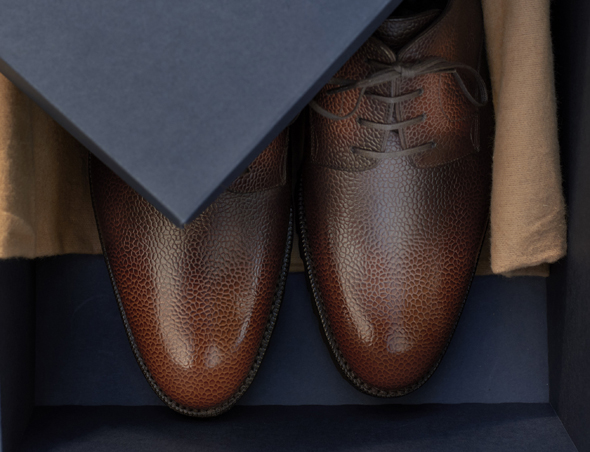
Build it again,
Build it aloft in thy breast!
And life’s new quest
Commence
With clearer sense,
And songs of cheer
Anew shalt hear!
—Goethe, Faust
So the words were spoken by the Choir of Spirits in Goethe’s Faust, and thus the collaboration between Snøhetta architecture and Faust shoes reinvented the shopping experience. By bringing the old into the new, Faust shoe designer, Alvaro Miranda, has brought about a rebirth to an almost extinct art: cordwaining. To celebrate this renaissance, Miranda has opened his first retail location in Oslo, Norway, and entrusted Norwegian design and architecture firm, Snøhetta, to create the transformative space. Much like the bespoke shoe designs, Snøhetta’s design for the shop was measured, cut and molded specifically to create a one-of-a-kind experience.
A cordwainer, by definition, is a shoemaker—not to be confused with a cobbler. But, to be a cordwainer, or cordonnier in its original French form, is a special skill that developed in the middle ages. Now, of course, with mass-production of everything, handmade leather shoes have become a luxury and the craft almost obsolete. But Miranda is creating genuine leather shoes, made to order, or handmade and ready-to-wear, for customers who seek quality.
Faust shoes were primarily available online, and the designs were custom-made for each client. It seems only fitting that the first physical location would be tailor-made to Miranda’s specifications and to the simple, yet elegant tastes of his customers. He and Snøhetta worked hand-in-hand to forge this environment. This is not an unusual practice for Snøhetta, “We are always working closely with the client,” a Snøhetta representative revealed. “ Their inspiration and passion inspires us and our ideas of how spaces can be formed and designed.” While Miranda naturally dictated his desires for the space, Snøhetta was given license to do what they felt was best to achieve the goal. “Alvaro was hands-on and at the same time, let us develop the idea to create a cohesive final result. With that is the trust the he had in us. And together we created his environment.”
Like the world Alice encounters on the other side of the looking glass, the Snøhetta-designed shop hides a metamorphic interior behind its prosaic façade. Upon entering, it’s as if one has actually walked into a Faustian world, and Oslo has been left behind. “There is a feeling of entering a new space, a transition,” agreed one of the firm’s designers. “For being a very small room, you have an overwhelming sense of grandness and importance.” While the name Snøhetta may not be commonplace to many, a quick internet search will lead to its prolific repertory of impressive buildings with refined, yet almost surreal designs. Thus, we discover Snøhetta’s history with such transcendent projects as Faust. They are no stranger to sublime architecture; their repertoire includes awe-inspiring works, like the expansion to the SFMOMA, where the façade looks other-worldly, yet still blends in seamlessly with the city.
“The goal and our approach are to have a holistic design. By definition, it is to ‘Emphasize the importance of the whole and the interdependence of its parts.’ That is what allows the customer to feel innately the design intentions of both the products and the environment, in which they are set. We truly believed in the quality and authenticity of Faust and wanted to create an environment that expressed this.”
Inside Faust, lofty, built-in, hardwood arches reach up to the dark, soaring ceiling, and the recessed niches provide seating and storage. The incorporated cabinetry is functional yet sumptuous. Aside from the natural grain of the wood and the subtle texture of the concrete, there is very little decoration to distract from the shop’s true purpose—to display the craftsmanship of Miranda’s hand-made leather shoes. Not digressing far from the architectural principle of ‘form over function,’ the store takes on a ‘diagrammatic’ layout, but ‘praise to the craft and craftsman inspired the grand elements and way of displaying and presenting the tailor-made shoes.’ Punctuating the space between niches are glossy wooden panels with a discreet diamond pattern—almost a trompe l’oeil—that juxtaposes simplicity with intricacy. And, as a final accent, the Faust logo in gold lettering adorns the doors, shoeboxes and stationery. The space is certainly not austere, but there is no superfluous extravagance to distract from the primary objective of the store.
“So that, footloose, fancy free,
You can experience Life, with me”
Text by Leah Tassinari

